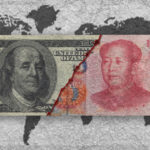Gold Glitters in China’s Financial Storm
THANK YOU FOR POSTING A REVIEW!
Your review was sent successfully and is now waiting for our staff to publish it.

(October 2, 2023 - Frank Holmes)
The Chinese yuan has lost nearly 6% of its value against the U.S. dollar this year, while Shanghai-listed stocks are off about 8% from their 2023 high, set back in May. There’s an ongoing property crisis, with shares of Evergrande Group—China’s second-largest property developer and the world’s most indebted—halting trading last Thursday after its founder and chairman was reportedly taken into police custody for unknown reasons.
Against this backdrop, gold has emerged as a preferred investment alternative, acting as a hedge against financial volatility.
Gold prices in China have soared as a result, hitting a historic relative high with a more than $100 premium per ounce over metal prices in New York or London, according to Bloomberg. Data showing a 40% hike in withdrawals from the Shanghai Gold Exchange and a 15% increase in imports in August further underscore this trend.

Looking ahead, analysts predict sustained demand for the yellow metal amid not just a depreciating yuan and shaky real estate market but also falling bond yields. The gold buying spree appears to represent an investment move—sales of bars and coins are up 30% compared to last year—but rising prices are also tempting jewelry buyers to make early purchases ahead of the busy Lunar New Year buying season.
Official Gold Reserves at a New Record High?
It’s not just China’s retail investors. The People’s Bank of China also continues to diversify its reserves with gold, so much so that one expert believes total official gold holdings by central banks have touched a new all-time high. Jan Nieuwenhuijs, writing for Gainesville Coins, estimates that global gold reserves peaked at 38,764 metric tons in June, surpassing the previous 1965 record by as much as 400 tons.
Nieuwenhuijs’s estimate, which accounts for unreported purchases unlike the International Monetary Fund’s (IMF) calculations, shows a notable increase in gold holdings since the 2008 financial crisis, as you can see in the chart below. This reflects what he calls a “desire by central banks the world over to diversify away from the U.S. dollar with its ever more evident counterparty risks.”

-
Switzerland Emerges As India’s Top Import Destination In April With Soaring Gold Imports By
Mint State Gold
May 16 2024
-
Silver Surges To Highest Settlement In 11 Years Gold Jumps As U.S. Inflation Cools By
Mint State Gold
May 16 2024






